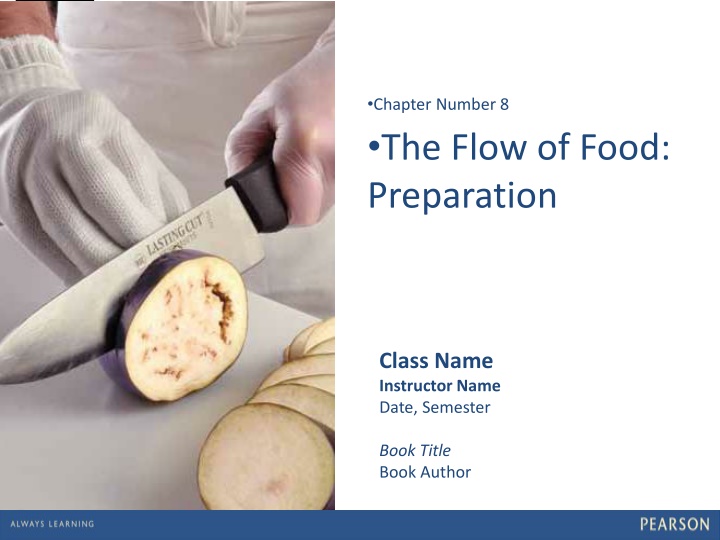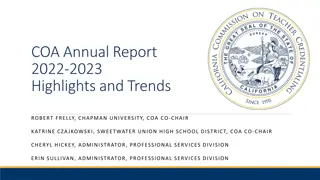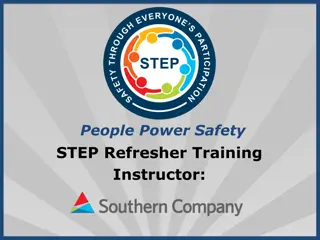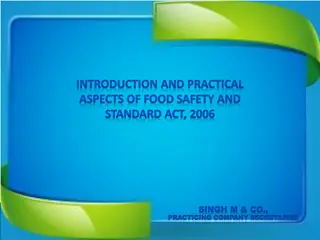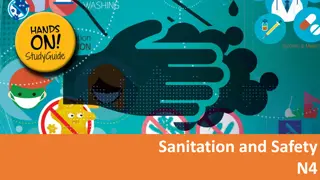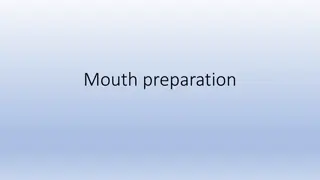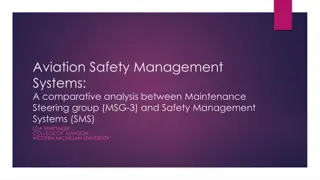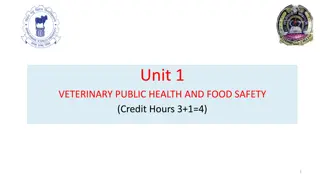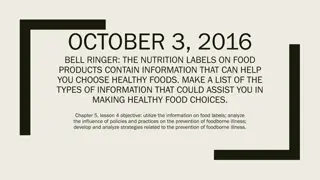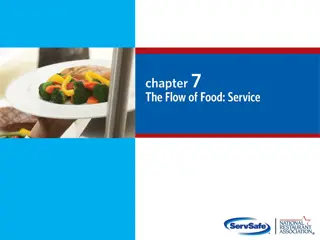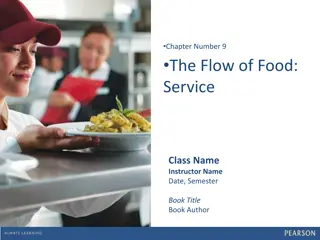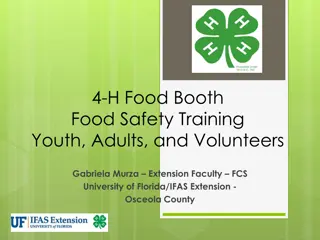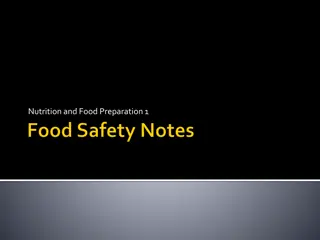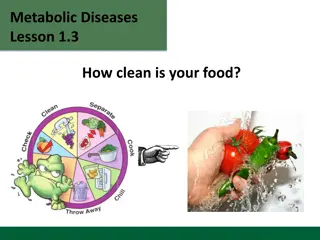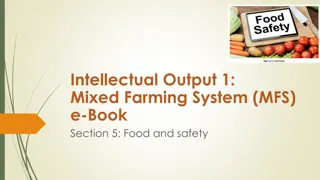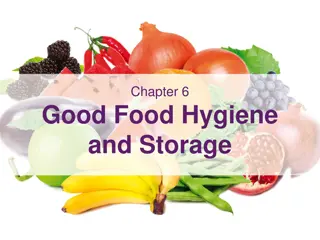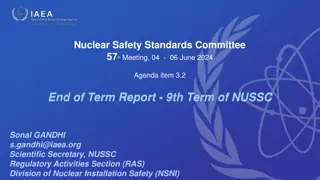Best Practices for Food Preparation to Ensure Food Safety
This chapter highlights essential practices for prepping food to prevent cross-contamination and time-temperature abuse in a food service setting. Topics covered include safe methods for thawing food, cooking temperatures, microwave cooking, informing consumers of risks, requirements for partially cooking and cooling TCS food, and more. Detailed guidelines on equipment cleanliness, storage, additive usage, and food presentation are provided to maintain food safety standards and avoid misleading customers.
Download Presentation

Please find below an Image/Link to download the presentation.
The content on the website is provided AS IS for your information and personal use only. It may not be sold, licensed, or shared on other websites without obtaining consent from the author.If you encounter any issues during the download, it is possible that the publisher has removed the file from their server.
You are allowed to download the files provided on this website for personal or commercial use, subject to the condition that they are used lawfully. All files are the property of their respective owners.
The content on the website is provided AS IS for your information and personal use only. It may not be sold, licensed, or shared on other websites without obtaining consent from the author.
E N D
Presentation Transcript
Chapter Number 8 The Flow of Food: Preparation Class Name Instructor Name Date, Semester Book Title Book Author 1
Learning Objectives After this presentation, you should be able to complete the following Learning Outcomes 8.0 Correct ways for prepping food to prevent cross- contamination and time-temperature abuse 8.1 Safe methods for thawing food 8.2 The minimum internal cooking temperatures for TCS food 8.3 The correct way to cook TCS food in a microwave oven 8.4 2
Learning Objectives After this presentation, you should be able to complete the following Learning Outcomes 8.0 The importance of informing consumers of risks when serving raw or undercooked food 8.5 Requirements for partially cooking TCS food 8.6 Methods and time-temperature requirements for cooling TCS food 8.7 Time and temperature requirements for reheating TCS food 8.8 3
8.0 KEY TERMS Date marking: A date on ready-to-eat TCS food held for more than 24 hours indicating by when the food must be sold, eaten, or thrown out. First-in, first-out (FIFO): Method of stock rotation in which products are shelved based on their use-by or expiration dates, so oldest products are used first. Reduced-oxygen packaged (ROP) food: Packaging method that reduces the amount of oxygen available in order to slow microbial growth. ROP methods include sous vide, MAP, and vacuum packaging.
Correct ways for prepping food to prevent cross- contamination and time-temperature abuse 8.1 GENERAL PREPARATION PRACTICES Cross-contamination and time-temperature abuse can happen easily when you are prepping food. You can prevent pathogens from spreading and growing by making good food-prep choices. Equipment Make sure workstations, cutting boards, and Utensils are clean and sanitized. Quantity Only remove as much food from the cooler as you can prep in a short period of time. In the photo, the food handler has taken out too much tuna salad. Storage Return prepped food to the cooler, or cook it as quickly as possible.
Correct ways for prepping food to prevent cross- contamination and time-temperature abuse 8.1 GENERAL PREPARATION PRACTICES (cont.) Additives If you use food or color additives when prepping food, follow these guidelines: Only use additives that have been approved by your local regulatory authority. Never use more than is allowed by law. Never use additives to alter the appearance of the food. Do not sell produce that was treated with sulfites before it was received in the operation. Do not add sulfites to produce that will be eaten raw. Presentation food should be offered to customers in a way that does not mislead or misinform them. Customers must be able to judge the true appearance, color, and quality of food. Do not use the following to misrepresent the appearance of food: Food additives or color additives Colored overwraps Lights
Correct ways for prepping food to prevent cross- contamination and time-temperature abuse 8.1 CORRECTIVE ACTIONS Food that has become unsafe should be thrown out unless it can be safely reconditioned. All food especially ready-to-eat food should be thrown out in the following situations: When it is handled by staff who have been restricted or excluded from the operation because of illness When it is contaminated by hands or bodily fluids from the nose or mouth When it has exceeded the time and temperature requirements designed to keep food safe Sometimes food can be restored to a safe condition. This is called reconditioning. For example, a hot food that has not been held at the correct temperature may be reheated if it as not been in the temperature danger zone for more than two hours. This can return food to a safe condition.
8.2 Safe methods for thawing food THAWING Freezing food does not kill pathogens. If frozen food is exposed to the temperature danger zone during thawing, any foodborne pathogens present will begin to grow. That is why food should not be thawed at room temperature. To prevent pathogen growth, thaw TCS food in one of the following ways: Cooler Thaw food in a cooler keeping its temperature at 41 F (5 C) or lower. This requires advance planning. Larger items, such as a turkey, can take several days to thaw completely in a cooler. Running water Submerge the food under running drinkable water at a temperature of 70 F (21 C) or lower. The flow of the water should be strong enough to wash loose food into the drain. Always use a clean and sanitized prep sink when thawing food this way. Do not let the temperature of the food go above 41 F (5 C) for longer than four hours.
8.2 Safe methods for thawing food THAWING (cont.) To prevent pathogen growth, thaw TCS food in one of the following ways: Microwave Thaw food in a microwave oven if it will be cooked immediately after thawing. The food must be cooked in conventional cooking equipment, such as an oven, once it is thawed. Cooking Thaw food as part of the cooking process. Always verify the final internal cooking temperature with a thermometer. Slacking Gradual thawing of frozen food Allows even heating during cooking
The minimum internal cooking temperatures for TCS Food 8.3 COOKING FOOD The only way to reduce pathogens in food to safe levels is to cook it to its minimum internal temperature and hold that temperature for a specific amount of time. While cooking can reduce pathogens in food to safe levels, it will not destroy spores or toxins they may have produced. For this reason, it is critical to handle food correctly before it is cooked.
The minimum internal cooking temperatures for TCS Food 8.3 POULTRY AND GROUND MEAT Poultry including whole or ground chicken, turkey, or duck Stuffing made with fish, meat, or poultry Stuffed meat, seafood, poultry, or pasta Dishes that include previously cooked TCS Ingredients (raw ingredients should be cooked to their minimum internal temperatures) Ground meat including beef, pork, and other meat Injected meat including brined ham and flavor-injected roasts Mechanically tenderized meat Ratites including ostrich and emu Ground seafood including chopped or minced seafood Shell eggs hot-held for service
The minimum internal cooking temperatures for TCS Food 8.3 STEAK & CHOPS AND ROASTS Steaks/chops of pork, beef, veal, and lamb Seafood including fish, shellfish, and crustaceans Commercially raised game Shell eggs that will be served immediately Roasts of pork, beef, veal, and lamb Roasts may be cooked to these alternate cooking times and temperatures depending on the type of roast and oven used: 130 F (54 C) 112 minutes 131 F (55 C) 89 minutes 133 F (56 C) 56 minutes 135 F (57 C) 36 minutes 138 F (59 C) 18 minutes 140 F (60 C) 12 minutes 142 F (61 C) 8 minutes 144 F (62 C) 5 minutes
The minimum internal cooking temperatures for TCS Food 8.3 FRUIT, VEGETABLES, GRAINS, LEGUMES, AND TEA Fruit, vegetables, grains (rice, pasta), and legumes (beans, refried beans) that will be hot-held for service Tea Automatic iced tea and automatic coffee machine equipment: Tea leaves should remain in contact with the water for a minimum of one minute. Traditional steeping method: Tea leaves should be exposed to the water for about five minutes.
The correct way to cook TCS food in a microwave oven 8.4 COOKING TCS FOOD IN THE MICROWAVE Meat, seafood, poultry, and eggs that you cook in a microwave oven must be cooked to 165 F (74 C). In addition, follow these guidelines: Cover the food to prevent its surface from drying out. Rotate or stir it halfway through the cooking process so that the heat reaches the food more evenly. Let the covered food stand for at least two minutes after cooking to let the food temperature even out. Check the temperature in at least two places to make sure that the food is cooked through.
The importance of informing consumers of risks when serving raw or undercooked food 8.5 CONSUMER ADVISORIES You must cook TCS food to required minimum internal temperatures unless you inform customers that an item is raw or undercooked. Disclosure: If your menu includes TCS items that are raw or undercooked, you must note it on the menu next to these items.
The importance of informing consumers of risks when serving raw or undercooked food 8.5 CONSUMER ADVISORIES (cont.) This can be done by placing an asterisk next to the item that points customers to a footnote at the bottom of the menu. The footnote must include a statement that indicates the item is raw or undercooked, or contains raw or undercooked ingredients.
8.6 Requirements for partially cooking TCS food PARTIALLY COOKING DURING PREPPING Some operations partially cook food during prep and then finish cooking it just before service. Follow the steps below if you plan to partially cook meat, seafood, poultry, or eggs or dishes containing these items: Do not cook the food for longer than 60 minutes during initial cooking. Cool the food immediately after initial cooking. Freeze or refrigerate the food after cooling it. If refrigerating the food, make sure it is held at 41 F (5 C) or lower. Heat the food to at least 165 F (74 C) for 15 seconds before selling or serving it. Cool the food if it will not be served immediately or held for service.
8.6 Requirements for partially cooking TCS food PARTIALLY COOKING DURING PREPPING Some operations partially cook food during prep and then finish cooking it just before service. Follow the steps below if you plan to partially cook meat, seafood, poultry, or eggs or dishes containing these items: Do not cook the food for longer than 60 minutes during initial cooking. Cool the food immediately after initial cooking. Freeze or refrigerate the food after cooling it. If refrigerating the food, make sure it is held at 41 F (5 C) or lower. Heat the food to at least 165 F (74 C) for 15 seconds before selling or serving it. Cool the food if it will not be served immediately or held for service.
8.6 Requirements for partially cooking TCS food PARTIALLY COOKING DURING PREPPING (cont.) Your regulatory authority may require that you have written procedures explaining how food cooked in this way will be prepped and stored. They need to be approved by the regulatory authority and describe the following: How the requirements will be monitored and documented Which corrective actions will be taken if requirements are not met How these food items will be marked after initial cooking to indicate they need further cooking How these food items will be separated from ready-to-eat food during storage, once initial cooking is complete
TEMPERATURE REQUIREMENTS FOR COOLING TCS FOOD 8.7 Temperature Requirements for Cooling Food As you know, pathogens grow well in the temperature danger zone. They grow even faster between 125 F and 70 F (52 C and 21 C). Food must pass through this temperature range quickly to reduce this growth. Cool TCS food from 135 F to 41 F (57 C to 5 C) or lower within six hours.
TEMPERATURE REQUIREMENTS FOR COOLING TCS FOOD 8.7 COOLING AND REHEATING TCS FOOD If food has not reached 70 F (21 C) within two hours, it must be reheated and then cooled again. If you can cool the food from 135 F to 70 F (57 C to 21 C) in less than two hours, you can use the remaining time to cool it to 41 F (5 C) or lower. However, the total cooling time cannot be longer than six hours.
TEMPERATURE REQUIREMENTS FOR COOLING TCS FOOD 8.7 METHODS FOR COOLING FOOD The following factors affect how quickly food will cool: Thickness or density of the food: The denser the food, the more slowly it will cool. Size of the food: Large food items cool more slowly than smaller items. To let food cool faster, you should reduce its size. Cut large food items into smaller pieces. Divide large containers of food into smaller containers or shallow pans.
TEMPERATURE REQUIREMENTS FOR COOLING TCS FOOD 8.7 METHODS FOR COOLING FOOD Storage container: The container in which food is stored also affects how fast it will cool. Stainless steel transfers heat away from food faster than plastic. Shallow pans disperse heat faster than deep ones. Do not cool large amounts of hot food in a cooler. Most coolers are not designed to cool large amounts of hot food quickly. Placing hot food in the cooler may also not move it through the temperature danger zone fast enough. You can cool food quickly and safely in the following ways: Ice-water bath After dividing food into smaller containers, place them into a clean prep sink or large pot filled with ice water. Stir the food often to cool it faster and more evenly. Ice paddle Plastic paddles are available that can be filled with ice or with water and then frozen.
TEMPERATURE REQUIREMENTS FOR COOLING TCS FOOD 8.7 METHODS FOR COOLING FOOD Blast or tumble chiller Blast chillers blast cold air across food at high speeds to remove heat. They are typically used to cool large amounts of food. Tumble chillers tumble bags of hot food in cold water. Tumble chillers work well on thick food, such as mashed potatoes. Ice or cold water as an ingredient When cooling soups or stews, the recipe is made with less water than required. Cold water or ice is then added after cooking to cool the food and provide the remaining water. Storing Food for Further Cooling Loosely cover food containers before storing them. Food can be left uncovered if stored in a way that protects it from contaminants. Storing uncovered containers above other food, especially raw meat, seafood, and poultry, will help prevent cross-contamination.
Time and temperature requirements for reheating TCS food 8.8 METHODS FOR REHEATING FOOD How you reheat food depends on how you intend to use the food Follow these guidelines when reheating food: Food reheated for immediate service: You can reheat food that will be served immediately, such as beef for a beef sandwich, to any temperature. However, you must make sure the food was cooked and cooled correctly. Food reheated for hot-holding You must reheat TCS food for hot-holding to an internal temperature of 165 F (74 C) for 15 seconds. Make sure the food reaches this temperature within two hours from start to finish. These guidelines apply to all reheating methods, such as ovens or microwave ovens. Reheat commercially processed and packaged ready-to- eat food to an internal temperature of at least 135 F (57 C). This includes items such as cheese sticks and deep-fried vegetables.
